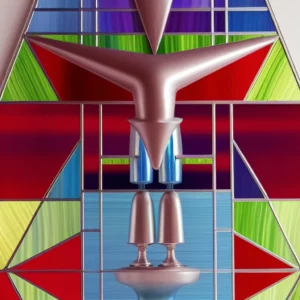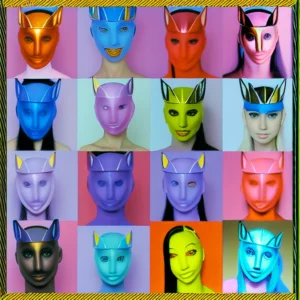Polarity
In my last article on The #1 Mistake People Make When Using the Law of Attraction, I stated that every intention has a content component plus an energy component, and both are equally important when it comes to applying the Law of Attraction. At the end of that article, I asserted that the energy component of every intention has a polarity. Now we’re going to explore polarity, which is the key to understanding intentional energy.
Do your best to keep an open mind as you read this article. The concepts are what’s important here, so try not to get hung up on the particular words I use to describe them.
What is polarity?
In order to define polarity, we need to build a bit of conceptual scaffolding first, so let’s dive in and explore the nature of thought.
As a conscious being, you have the ability to create thoughts. If you decide to think of an apple, you can obviously do that.
Every thought consists of two primary components: (1) content and (2) energy. I’m going to define these first, and then we’ll get to polarity.
Thought content
The content of a thought is the raw information it contains. If you think of an apple, the content is your internal representation of that apple. If you form an intention to have a million dollars, the content is the request for a million dollars.
The content portion of a thought contains no emotion itself. Content is what you get when you reduce a thought to something that could be stored in a computer database or typed up as an email. Even if the original thought is highly emotional, the content portion is the emotionless representation of that thought, such as the sentence “I am angry” to represent the real-life emotion of anger.
This definition of content is simply an abstraction to help us better understand the energy component. I’m not suggesting that your thoughts actually separate themselves into separate components. What I’m suggesting is that this model will be helpful to you in creating thoughts that have more power to manifest what you desire.
Thought energy
Now let’s define energy. Energy is the non-content portion of a thought. This concept is very difficult to explain in words because as soon as we reduce it to words, we end up with content, not energy. So my words can never do the concept justice, just as the word “joy” can never convey the actual experience of joy.
Intuitively you already have a grasp of the energy component of your thoughts, so I think the best way to define energy is to allow you to experience it subjectively right now. Here’s a simple exercise you can do in about one minute to demonstrate thought energy (this will be very familiar to anyone who’s studied NLP):
Try holding the thought “I am happy” in your mind right now. Just humor me and hold that thought for a few seconds. Notice how you feel when you hold this thought.
Now hold that same thought (identical content)… but with more energy this time. Do whatever you think is necessary to make the “I am happy” thought more intense in your mind — smile, change your position, breathe more deeply, stand up, stick your chest out, look up, move around, etc. Hold the thought at that new energy level for a few more seconds. Notice the difference in how this thought feels compared to the first thought. Can you perceive the increased energy even as the pure content of the thought remains unchanged?
Now lower the intensity, and bring the energy of the “I am happy” thought back down. Strip the thought of all its energy, and reduce it in your mind to pure content. It is nothing but a boring sentence. Hold the thought as pure content for a few more seconds. Notice how that feels compared to the first two thoughts. Can you sense the energetic difference?
Even though the content is the same in all three situations, your subjective experience of these thoughts will be totally different. Objectively speaking, your breathing, physiology, and movement will change to reflect the energy of the thought you’re holding. If someone else were doing this exercise in front of you, you would be able to perceive the differences. It isn’t difficult to gauge the intensity of someone’s thought energy by observing their physiology. This is especially easy to do with children who are less apt to disguise their emotional state.
Energy and emotion
Now you might be thinking that energy and emotion are the same thing. They’re related, but they’re definitely not the same. Emotion is to energy as heat is to fire. The flow of thought energy creates emotion, just as fire produces heat. If you hold a thought with strong energy, you will feel strong emotion. If you hold a thought with weak energy, you will feel little or no emotion.
Energy is not something you can create or destroy. It simply exists. It is ever-present and always available. What makes you feel strong emotion is not the energy itself (which is ever-present) but rather the flow of energy coursing through you.
Some self-help gurus suggest you can increase your ability to manifest your desires (or achieve your goals) by injecting more emotion into your thoughts. That advice is misguided. It’s like saying you can make a fire burn hotter by turning up the heat in the room. Technically that’s true, but it’s a highly inefficient strategy, and you’ll end up investing more energy than you gain. If you want your fire (intention) to burn hotter, you should add more fuel (energy), and you’ll generate more heat (emotion) as a natural consequence.
Once you understand energy and begin to play with it (especially after you learn about polarity), you’ll find it a lot easier to generate intense emotional states simply by visualizing the energy flow. It isn’t necessary to flap your arms like a dork in order to whip yourself into an emotional frenzy. 🙂
Contrary to popular belief, an intense emotion like passion does not fuel or motivate activity. Passion is not the real source of drive and motivation. Passion itself is a byproduct of high thought energy. The reason you see passion and motivated action together is that they’re both outcomes of the flow of thought energy. Without thought energy, there is no passion, no activity, and no manifesting.
So the process of generating results works like this:
Intention (Content + Thought Energy) -> Passion + Direct Action + Passive Manifesting -> Results
In every situation the particular mixture of passion, action, and manifesting will be different, but the ultimate cause of the whole chain of events is the original intention. I view direct action and passive manifesting as basically the same thing because when passion is high, action becomes fun and effortless anyway.
Remember that we’re talking energy here, not content. You can spend hours holding low-energy thoughts with great content (such as by reciting daily affirmations), and you will manifest virtually no passion, no activity, and no results. Similarly you can hold thoughts with really lame content but high energy, and you will feel a surge of motivation to passionately pursue them and generate results. I’m sure you’ve had experiences with both of these extremes.
What’s really fascinating to me is that when I form a powerful intention, one I’ve loaded with thought energy, other people (especially those who are energetically sensitive) can begin to pick up on it long before the intention physically manifests. For example, a few people have told Erin about dreams they’ve had about me doing certain things, including specific details that are rather unusual. Those details were part of some very strong intentions I put out, but I haven’t told anyone about them, not even Erin. I think that on some level, this thought energy is beginning to resonate with those who will eventually be involved in its manifesting. Even though these are intentions that may take a decade or more to fully manifest in physical form, on an energetic level the creation has already been set in motion.
Energy as a practical tool
Depending on your particular belief system, other terms you can use in place of energy are chi, qi, the Holy Spirit, prana, mana, life force, the Tao, morphogenic fields, psychic energy, etc. It doesn’t matter what term you use. The concept is all that matters.
I’m not asserting a spiritual philosophy here. I’m simply presenting a tool you can use. I view the concept of thought energy much like a mathematical construct. For example, consider the mathematical concept of imaginary numbers, based on taking the square root of -1. Imaginary number space does not exist in a real physical sense, but the concept can still be used to solve interesting problems and generate results with enormously practical applications.
Energy flow and skill
As a conscious being, you have the ability to direct the flow of universal energy. In fact the ability to do this is one of the most fundamental skills of consciousness. I say it’s a skill because there are varying degrees of competency. Like any other skill, you will have some level of innate ability in this area, but you can also improve with practice. However, expecting to master this skill overnight is extremely naive. If you’re having magical fantasies that all your problems will vanish instantly the first time you try this, I suggest you read What Are the Odds of Becoming a Black Belt?
Becoming skillful at directing energy flow takes dedication, practice, and perseverance. If you’re looking to the LoA as a way to get something for nothing, you’ll need to do a bit of growing up first.
Your ability to successfully apply the LoA depends on your ability to generate energy flow. If you cannot achieve a strong flow (as evidenced by your direct experience of intense emotional states), you will fail miserably and get no results. That isn’t the end of the world, but it does mean that you’ll spend far more time servicing other people’s intentions instead of enjoying the fulfillment of your own.
A pattern you will see repeatedly with newcomers to the LoA is that they form intentions that are all content and no energy. They tweak the content again and again, mistakenly thinking that better content is the answer, but they never manage to build sufficient intensity on the energy side. When these people talk about their intentions, it’s like listening to a Vulcan. There’s no passion, no fire, no energy behind their words. If they actually injected energy into their intentions, they’d be speaking like a Vulcan going through Pon Farr.
Many people who achieve poor results when trying to apply the Law of Attraction simply lack skill in creating and sustaining energy flow. Please try to resist the temptation to conclude that the LoA doesn’t work. That’s like an American Idol reject complaining that sound waves don’t work because they didn’t pass their audition. The problem may simply be that you downright suck. But it’s OK to suck. Remember this line from The Matrix: “Everyone falls the first time.” You just need to build your skill level. If you really can’t suppress the urge, go ahead and throw a “poor me” tantrum in the hallway on the way out, but it’s only going to make you look stupid in the eyes of those who know what they’re doing, and it won’t bring your intentions any closer to manifesting. On the bright side, your parting shot may be a source of entertainment for others, so just pretend we’re all laughing with you.
In all fairness to those who are struggling with the LoA and making these newbie mistakes, it isn’t really your fault. There’s a tremendous amount of marketing hype surrounding the LoA these days that vastly oversimplifies its true complexities and leaves people thinking they can expect instant results overnight. The something-for-nothing crowd is going to be disappointed as they always are, but those who look beneath the surface and probe its depths will find something wonderful. Just do your best to ignore the marketing hype without feeling a need to attack or defend it. You can continue to pursue the LoA without spending a dime if the hype onslaught makes you nauseous.
Polarity
Now we’re finally ready to explore the concept of polarity. This is a very key concept to understanding how to create high-energy intentions.
Thoughts have content and energy, and polarity is a property of the energy component. When we consider the energy of a thought, we’re really talking about the energy flow. But in order to have a flow, we need a direction.
What are the possible directions of energy flow? With respect to your consciousness, there are only two directions that make sense: into your consciousness or out from your consciousness. Energy can flow towards you, or it can flow away from you. It’s like you’re a vacuum cleaner that has two airflow settings: suck and blow.
Boy you have a dirty mind, but let’s stick with the concept of energy flow for now, OK?
The polarity of the energy flow is simply its direction. The in-flowing energy has one polarity, and the out-flowing energy has the opposite polarity.
So here are the two basic ways energy can flow through your consciousness:
- You -> Universe (you direct energy from your consciousness out to the universe)
- Universe -> You (you draw energy from the universe into your consciousness)
#1 is like breathing out, and #2 is like breathing in, except we’re talking energy instead of air.
I’m not saying this is any kind of physical energy flowing through your physical body. It’s best to treat this as a conceptual tool. If you want to argue that there’s no such thing as this form of energy, I’ll simply agree with you, just as I’ll agree there’s no such thing as imaginary numbers. However, I’ll continue using both as tools.
Choosing polarity
The polarity of every thought is either outward or inward but never both. Actually a thought could be totally neutral as well, which would mean that it has content but no energy, and since it has no energy, it can’t be polarized. An example would be imagining a pencil or holding some other emotionless idea in your mind that you don’t connect with an energy flow.
Now here’s the rub. These two different energy polarities are incompatible with each other. When you have both polarities present at the same time and in the same magnitude, they cancel each other. The process works like vector addition. If you add two opposing vectors of equal magnitude, you end up with a zero vector. If one vector is slightly longer than the other, you’ll have some energy left over, but it will be significantly less that the total energy you’ve invested. Imagine adding 10 units of in-flowing energy with 8 units of out-flowing energy. You’ve invested 18 units total, but you’ll only end up with a net 2 units of in-flowing energy because 8 units of energy on each side will simply cancel out. In effect you are working against yourself.
Not understanding polarity is a source of tremendous frustration when applying the LoA, since it’s entirely possible to inject lots of energy into your intentions but get little or no results if you’re mixing both polarities together. Unfortunately it’s very easy to do this by default. If you want to manifest a particular desire, you’ll achieve the best results by picking a single polarity and using it consistently.
Polarizing your intentions
Based on the polarity concept, there are a couple things we can say about intentions:
- An intention without a strong polarity is very weak and has little power to manifest
- An intention with a strong polarity is very strong and has significant power to manifest
To polarize an intention, you must energize it with directional energy. The energy must either flow outward or inward but not both.
Understand that with respect to this model, everything is energy, so although the content of your intentions may seem to have nothing to do with energy, ultimately you can think of your intentions in terms of some kind of flow, and that flow is either coming into you or going out of you. An intention that doesn’t align with one of these natural flows will have virtually no power to manifest.
Here are some examples of intentions that align well with outflow (from your consciousness out to the universe):
- write a book
- build a business
- compose a song
- draw a picture
- throw a party
- give a speech
- start a blog
And here are some examples of intentions that align well with inflow (from the universe into your consciousness):
- get a new car
- attract a new relationship
- receive a certain sum of money
- get a new job
- achieve a certain reputation
- win a contest
Technically these lists have no energy (or polarity) because as plain text they reduce intentions to mere content, but I think you’ll see there’s a logical directional choice for the flow of energy for each example.
Outward flowing energy involves creation and giving. Inward flowing energy involves acquiring and receiving. Although these two energies may seem similar, they’re actually very distinct creatures.
It’s entirely possible to take the same content and apply either energetic polarity to it. For example, consider the intention of eating a nice dinner. You can imbue this intention with out-flowing energy by imagining it as a creative endeavor, focusing on the experience of preparing an interesting meal, concocting an original recipe, laying out the table, and perhaps sharing the food with others. You are adding to the substance of the universe. On the other hand, you can also fill this intention with in-flowing energy by focusing on appeasing your appetite, enjoying the taste and texture of the food, being served, and feeling satiated at the end of the meal. In this case you are receiving from the universe. Your dinner will turn out best if you pick one polarity or the other and stick with it. If you’ve never tried doing this consciously, I highly encourage you to do so.
To form a strong intention, think of that intention as either an inflow or an outflow of energy. Are you primarily creating or acquiring? It’s important to be crystal clear about which polarity you’re going to use.
If you can’t clarify your intention in terms of the inflow or outflow of energy, you’ll end up with a very weak intention that isn’t likely to manifest. When you form a true intention, either you’re giving something to the universe, or you’re getting something from it. While you may in fact experience both results as your intention manifests (giving leads to getting and vice versa), what’s important here is that you focus your intentional energy on either one direction or the other but not both. Your attention must be concentrated either on sending energy out or on drawing energy in.
There is no right or wrong choice of polarity except not to choose one. If you imbue your intentions with energy of mixed polarity, you’re only wasting your efforts. The two energies will simply neutralize each other.
Polarized emotional feedback
These concepts may be easier to understand if you look at them from another angle: the emotional output of polarized energy. If you apply highly polarized energy to your intentions, you will experience a strong surge of emotion. But that emotional surge will be totally different depending on your choice of polarity.
If you use the polarity of creation and giving (outflow), you will experience a surge of related emotions such as love, joy, and inspiration.
If you use the polarity of acquisition and receiving (inflow), you will experience a surge of related emotions such as greed, lust, and power.
These polarized emotional states are incompatible with each other, which is what we’d expect as a result of the underlying energies being incompatible. However, a peak emotional state on either side can be labeled as a form of passion. On either side you will experience intense, highly motivating emotional states.
Based on the emotional consequences, your social conditioning, and your personality, you may have a bias towards one polarity or the other. (That’s a whole other article.) But as far as the universe is concerned, these polarities are equally acceptable. To say that one is better than the other is to say that breathing in is better than breathing out.
If you experience no surge of emotion when focusing on your intentions, suffice it to say that either you aren’t putting enough energy into them, or you’re injecting them with energy of mixed polarity.
As an example, to write this article I am using the polarity of outflow. My intentional energy is focused on writing as an act of love, connection, creation, giving, and contribution. I am not thinking about what this article will do for me personally, what kind of feedback it will generate, how it will rank in search engines, or how much money I make from ad clicks, since those are all energetic signatures of the polarity of inflow. Consequently, this act of writing is an extremely enjoyable experience for me. The creative ideas flow easily and effortlessly, and emotionally I feel blissful and very fulfilled.
The exact words you use to phrase an intention are not that important unless they help you polarize one way or the other. You do not even need to put your intentions into words — you can hold them as pure thoughts, images, or sounds if you prefer. Imagine typing an email to someone. The exact words aren’t that important as long as you get your basic point across. But the message isn’t going anywhere until you click Send.
Your life experience has probably shown you that when you hold an intention with strong emotions, it’s very likely to manifest. For one, you’ll be extremely motivated to take action, but it may also seem like the universe is bending over backwards to help you get there. In those situations you were using polarized energy, intensely focusing on either the outward flow of creative expression (giving) or the inward flow of acquisition (receiving). Instead of mixing those two polarities together, you primarily focused on one side or the other. It was either “I want to give” or “I want to get.” And you felt an intense emotional surge as a natural consequence of using polarized energy correctly.
I have much more to write on the topic of polarization, so please stay tuned. In the meantime I’d like to challenge you to simply observe energetic polarities flowing through your daily life. The only way you’ll truly understand the significance of polarity is by experiencing it for yourself. Whenever you observe yourself or someone else in an emotional state, stop and take notice of the energetic flow that’s present. What is its polarity? Is the focus on inflow or outflow?




